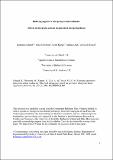Files in this item
Reducing aggressive intergroup action tendencies : effects of intergroup contact via perceived intergroup threat
Item metadata
| dc.contributor.author | Schmid, K. | |
| dc.contributor.author | Hewstone, M. | |
| dc.contributor.author | Küpper, B. | |
| dc.contributor.author | Zick, A. | |
| dc.contributor.author | Tausch, N. | |
| dc.date.accessioned | 2015-12-11T00:11:33Z | |
| dc.date.available | 2015-12-11T00:11:33Z | |
| dc.date.issued | 2014-05 | |
| dc.identifier | 97845620 | |
| dc.identifier | f28adc96-6f61-4e29-b99d-9a3f70b2195c | |
| dc.identifier | 84897507685 | |
| dc.identifier | 000333814800006 | |
| dc.identifier.citation | Schmid , K , Hewstone , M , Küpper , B , Zick , A & Tausch , N 2014 , ' Reducing aggressive intergroup action tendencies : effects of intergroup contact via perceived intergroup threat ' , Aggressive Behavior , vol. 40 , no. 3 , pp. 250-262 . https://doi.org/10.1002/ab.21516 | en |
| dc.identifier.issn | 0096-140X | |
| dc.identifier.other | ORCID: /0000-0002-9471-0673/work/46362103 | |
| dc.identifier.uri | https://hdl.handle.net/10023/7901 | |
| dc.description | Katharina Schmid and Miles Hewstone gratefully acknowledge support from the Leverhulme Trust that facilitated the writing of this paper. | en |
| dc.description.abstract | Two studies tested the prediction that more positive intergroup contact would be associated with reduced aggressive intergroup action tendencies, an effect predicted to occur indirectly via reduced intergroup threat perceptions, and over and above well-established effects of contact on intergroup attitudes. Study 1, using data based on a cross-section of the general population of eight European countries (France, Germany, Hungary, Italy, the Netherlands, Poland, Portugal, and the UK; N=7,042), examined this hypothesis in the context of aggressive action tendencies towards immigrants. Study 2, using longitudinal data obtained from a general population sample in Northern Ireland, considered effects on aggressive action tendencies between ethno-religious groups in conflict. Both studies confirmed our predictions, showing that while perceived threat was associated with greater intergroup aggressive tendencies, positive intergroup contact was indirectly associated with reduced aggressive action tendencies, via reduced intergroup threat. Findings are discussed in terms of the theoretical contributions of this research for understanding the relationship between intergroup contact and intergroup aggression. | |
| dc.format.extent | 13 | |
| dc.format.extent | 314008 | |
| dc.language.iso | eng | |
| dc.relation.ispartof | Aggressive Behavior | en |
| dc.subject | Intergroup contact | en |
| dc.subject | Aggressive action tendencies | en |
| dc.subject | Perceived intergroup threat | en |
| dc.subject | Intergroup conflict | en |
| dc.subject | Longitudinal data | en |
| dc.subject | BF Psychology | en |
| dc.subject.lcc | BF | en |
| dc.title | Reducing aggressive intergroup action tendencies : effects of intergroup contact via perceived intergroup threat | en |
| dc.type | Journal article | en |
| dc.contributor.institution | University of St Andrews. School of Psychology and Neuroscience | en |
| dc.contributor.institution | University of St Andrews. University of St Andrews | en |
| dc.identifier.doi | 10.1002/ab.21516 | |
| dc.description.status | Peer reviewed | en |
| dc.date.embargoedUntil | 2015-12-11 |
This item appears in the following Collection(s)
Items in the St Andrews Research Repository are protected by copyright, with all rights reserved, unless otherwise indicated.

